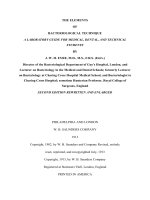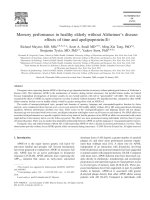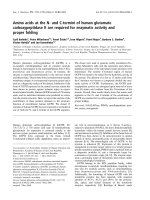Paul Ryan’s Plan foR MillionaiRes’ Gain and Middle-Class Pain pptx
Bạn đang xem bản rút gọn của tài liệu. Xem và tải ngay bản đầy đủ của tài liệu tại đây (132.35 KB, 8 trang )
EPI BRIEFING PAPER
EcoNomIc PolIcy INstItutE
●
jANuARy 19, 2011
●
BRIEFING PAPER #289
I
n January 2010, the incoming House Budget Committee Chairman Paul Ryan (R Wis.) presented “A Roadmap
for America’s Future,” in which he proposed drastic policy changes with the stated goal of “putting the nation on a
sustainable fiscal course” (Ryan 2010, iv). If enacted, Ryan’s Roadmap would dismantle social insurance programs,
raise taxes on the middle class, and transfer wealth from the middle class to corporations and millionaires.
Recent deficit reduction proposals, including those
from President Obama’s National Commission on Fiscal
Responsibility and Reform (the Fiscal Commission) and
the Bipartisan Policy Center’s Deficit Reduction Task
Force, have contained a mixture of revenue increases and
spending cuts to achieve long-term fiscal stability. e
Ryan Roadmap, on the other hand, makes no pretense of
a balanced approach. It would slash Medicare, Medicaid,
and Social Security benefits and deplete tax revenue. It
trades middle-class pain for millionaires’ gains.
e Roadmap is riddled with policies that ignore the
lessons learned from the Great Depression and under-
scored by the Great Recession. Policy and market failures
set the stage for a meltdown of the global financial system
and the worst recession since the Great Depression, but
Ryan’s plan still swears by the failed Bush-era economic
policies of cutting taxes for the wealthy while neglecting
the middle class and national investments. It even proposes
TABLE OF CONTENTS
1. The Ryan Roadmap raises taxes on Americans making
between $20,000 and $200,000 while slashing taxes
in half for the wealthiest Americans.
2. The Ryan Roadmap replaces corporate taxation with a
regressive consumption tax.
3. The Ryan Roadmap places the entire burden of
decit reduction on spending cuts
4. The Ryan Roadmap dismantles Medicare and
Medicaid, defunding important social programs
without addressing the rising cost of health care
throughout the economy4
5. The Ryan Roadmap cuts benets and partially
privatizes Social Security without improving
retirement security
An ideological attack on the safety net
PAUL RYAN’S PLAN FOR
MILLIONAIRES’ GAIN AND
MIDDLECLASS PAIN
The ‘Ryan Roadmap’ leads to an entitlement raid and
middle-class tax hikes in order to enrich the wealthy
By
●
●
the partial privatization of Social Security, an increase in
taxes on the middle class, the elimination of corporate
taxes, and the privatization of Medicare.
Among other changes, the Ryan Roadmap proposes:
Raising taxes • only on those Americans making between
$20,000 and $200,000, while slashing taxes in half
for the wealthiest Americans. e middle class would
pay higher average tax rates than millionaires – an
unprecedented reversal of progressive U.S. tax policy.
Eliminating taxation of corporate income and replacing •
it with a consumption tax that would dispropor-
tionately hit middle-class Americans.
Placing the entire burden of deficit reduction on •
spending cuts. e Ryan Roadmap prioritizes dis-
mantling social insurance programs, not balancing
the budget.
Replacing Medicare and Medicaid with inadequate •
vouchers to purchase health insurance in a broken
marketplace.
Privatizing Social Security for wealthy Americans •
and ending Social Security’s role as universal social
insurance with benefits tied to lifetime earnings.
1. The Ryan Roadmap raises
taxes on Americans making
between $20,000 and $200,000
while slashing taxes in half for
the wealthiest Americans.
e Ryan Roadmap would raise taxes on most Americans
earning under $200,000 while substantially reducing taxes
for wealthier Americans and cutting millionaires’ taxes in half.
Roughly three-quarters of Americans would face •
tax increases (Van de Water 2010a).
1
Middle-class
families would be hit particularly hard by a business
consumption tax. Elimination of the income and
payroll tax exclusion for employer-sponsored health
insurance, which would be replaced with a refundable
credit, would also raise taxes on families making over
$75,000 (TPC 2009).
2
e Roadmap would lead to the wealthiest Americans •
paying a lower average tax rate than most Americans.
Eliminating taxes on capital gains, dividends, and
interest, as the Roadmap proposes, would over-
whelmingly help taxpayers at the top of the income
distribution, who receive most or all of their income
from capital. For example, Wall Street financiers could
shelter all of their income as tax-free stock options or
carried interest.
Middle-class families earning between $50,000 and •
$75,000 a year would see their average tax rate jump
to 19.1% (from 17.7%) under this plan—an increase
of $900 on average—while families making more
than ten times that amount would see their taxes fall
substantially, from 25.3% to 18.3% (TPC 2010a).
Millionaires would see their average tax rate drop •
to 12.8%, less than half of what they would pay
relative to current policy, while a family making
between $30,000 and $40,000 would pay a higher
tax rate (TPC 2010a).
Put differently, families earning between $50,000 and
$75,000 would see average tax hikes of $900 to help fund
average tax cuts of more than $500,000 for millionaires.
And the super-rich would do much better than the merely
rich; the wealthiest 0.1% of taxpayers – those families
making almost $3 million or more – would see an average
tax cut of $1.7 million (TPC 2010b). e Ryan Road-
map would undermine the American commitment to
progressive taxation, which holds that the most fortunate
among us should pay a higher share of taxes.
3
2. The Ryan Roadmap replaces
corporate taxation with a
regressive consumption tax.
In addition to cutting taxes for the wealthiest Americans,
the Ryan Roadmap proposes eliminating the corporate
income tax and replacing it with a regressive consump-
tion tax that would disproportionately hit working-
class Americans.
Specifically, Ryan proposes replacing the corporate in-•
come tax system with a flat 8.5% business consumption
●
●
tax that would be levied on the difference between sales
and purchases. In essence, this is a value-added tax (VAT)
that would be passed on to consumers.
4
Not only would corporate taxes fall dramatically, but •
the profits passed on to owners and shareholders would
be tax free, generating significantly more wealth for
the owners of businesses.
e consumption tax would raise more than twice the
revenue needed to replace the corporate income tax; the
rest would help finance other tax cuts for the wealthiest
Americans.
5
is proposal represents a windfall for cor-
porate profits at the expense of working-class Americans
and would further exacerbate a dangerous trend of widening
income inequality. rough higher taxes and benefit cuts
affecting the broad swath of ordinary households, the Ryan
Roadmap leaves the middle class paying for sweeping tax
cuts for wealthy individuals and corporations.
3. The Ryan Roadmap places
the entire burden of deficit
reduction on spending cuts.
e hefty tax hikes on the middle class included in the
plan do not go toward deficit reduction. Nor does the
Roadmap’s overall revenue plan improve the long-term
fiscal outlook. e plan actually reduces federal revenue
relative to either current law or current policy.
e Tax Policy Center estimates that revenue would •
average only 16.3% of gross domestic product (GDP)
over 2011-20 despite the hefty tax increases on the
middle class because of the reduction in taxes on cor-
porations and wealthy individuals (TPC 2010c).
Under a current policy scenario, revenue would
average a much higher 18.6% of GDP over the same
period (CBO 2010b).
6
e projected decline in revenue primarily results from •
lowering individual income tax rates and eliminating
taxation of capital income (Rosenberg 2010).
Such an abrupt change in tax policy would be problematic
because: (1) revenue would fall well below historical trend
levels (worsening the country’s fiscal challenges, not
improving them) and (2) it fails to account for new costs
above and beyond those historical trends. Ignoring the
realities of an aging population, spiraling health costs,
and foreign military operations of unprecedented length,
revenue as a share of the economy would be cut well
below the already inadequate levels of the five decades
preceding the recession.
7
Current public investments and priorities are already
unfunded, and the Ryan Roadmap’s reduction in revenue
is coupled with a steep cut to already inadequate public in-
vestments. Based on the specific assumptions provided to
the Congressional Budget Office (CBO), the Ryan Road-
map would freeze nondefense discretionary spending at
2009 levels (CBO 2010c).
8
Public investments in key areas
like education, transportation infrastructure, health, and
basic scientific research would not be adjusted for inflation
or the demands of a growing population and economy.
Excluding funds from the American Recovery and •
Reinvestment Act (the Roadmap would rescind all
unspent discretionary Recovery Act funding), the
nonsecurity discretionary budget would be held at
$354.1 billion, currently 2.5% of GDP.
9
By 2015,
the nonsecurity budget would be cut by $74.6 billion
(17.4%) relative to the president’s budget request,
reducing spending to 1.9% of GDP (OMB 2010b).
By 2019, nonsecurity discretionary spending would •
see across-the-board cuts of 20.7% relative to main-
taining current levels of investment for inflation and
population growth.
10
Sacrificing public investment to cut taxes for the wealthiest
Americans would seriously undermine American pro-
ductivity and deprive the next generation of Americans
the education and resources to compete in the globalized
world economy. After the economy has strengthened,
deficit reduction will require a balanced approach of
targeted tax increases and spending cuts that protect
essential services and programs. e Ryan Roadmap, on
the other hand, takes a completely unbalanced approach.
e Ryan Roadmap explicitly prohibits revenue from
increasing above 19.0% of GDP, but in fact the tax pol-
●
●
icies in the plan fall well short of this level (Gleckman
2010). Because the burden of deficit reduction is placed
entirely on severe spending cuts, Americans in the middle
class would see their taxes increase while their Medicare
and Social Security benefits fell dramatically.
4. The Ryan Roadmap dismantles
Medicare and Medicaid,
defunding important social
programs without addressing
the rising cost of health care
throughout the economy.
e Ryan Roadmap dismantles Medicare and Medicaid
and replaces these social insurance programs with vouch-
ers, subsidies, and credits, leaving the elderly, poor, and
millions of children to fend for themselves in the health
insurance market. e problems with the American
health care system are clear for all to see: premiums rising
at double-digit rates, predatory insurance practices, and
poor health outcomes. e solution to these problems is
reforming the provision of care and improving access to
quality health care, not shifting costs and tweaking the
tax code. Instead, the Ryan plan would kill Medicare as we
know it in 2021 and with it the guarantee of health care
coverage in retirement.
Under the Ryan Roadmap, Medicare would be turned •
into a voucher (for those currently under the age of
55 – traditional Medicare would remain available
for those beneficiaries eligible before 2021), most of
Medicaid would be replaced with a health care subsidy,
the Children’s Health Insurance Program would be
fully eliminated, and the tax exemption for employer-
sponsored health care would be replaced with a
refundable tax credit (equivalent to a voucher).
e health insurance voucher, tax credit, and a federal •
Medicaid block grant for long-term care and disabled
populations would all be indexed to the halfway
point between inflation (CPI-U) and medical infla-
tion (CPI-M), which CBO estimates would average
2.7% annually over the next 75 years.
11
at rate
intentionally falls short of per capita health care cost
growth, which CBO estimates will average roughly
5.0% annually over the next 75 years (CBO 2010c).
Consequently, more and more of the cost of health care
would be shifted to consumers and states every year.
e vouchers would gradually decline in purchasing •
power, and the compounded effect would result in a
dramatic cut over time. CBO estimates that federal
spending on Medicare, that is, the total value of the
vouchers relative to promised fee-for-service benefits,
would fall by more than 75% over the next 70 years
(CBO 2010c).
12
For addressing the health care cost challenge, the Ryan
Roadmap is like applying a band-aid to mask but not
heal a serious affliction; states would need to raise taxes
and/or slash benefits, and consumers, particularly the
elderly and low-income families with children, would
have to pay significantly more out of pocket and forego
adequate care.
e Ryan Roadmap does not directly address the
challenge posed by the health care sector. Medicare and
Medicaid are neither overly generous nor the cause of
unsustainable health care cost growth rates. e critical
problem is that the private health care system, through
which both programs operate, provisions care inefficiently;
health expenditure is on a course to bankrupt households,
the private sector, and the public sector alike. e Ryan
Roadmap also assumes that insurance markets – which
have proven to be highly uncompetitive, profit-driven,
inefficient, and exploitative – will provide adequate care
to the elderly. But access to a health care voucher or
tax credit does not mean access to affordable health in-
surance. Leaving individuals to buy insurance in private
markets and undermining employer-sponsored care would
decimate risk pooling, which helps contain costs for most
individuals, and health insurance companies could price
premiums by age, gender, and health conditions. By shifting
costs to individuals and eliminating most risk pooling,
the Ryan Roadmap would lead to exceptionally high –
and in many cases unaffordable – insurance costs for the
elderly, thereby exacerbating retirement insecurity for the
middle class.
●
●
5. The Ryan Roadmap cuts benefits
and partially privatizes Social
Security without improving
retirement security.
Under the Ryan Roadmap, Social Security benefits would
be slashed for most taxpayers, and the wealthiest taxpayers
would be given the incentive and opportunity to divert a
substantial portion (if not all) of their payroll tax contri-
butions into private accounts. Consequently, the universal
Social Security insurance program would be gradually re-
placed with a two-tiered system of privatized accounts for
the wealthy and a schedule of reduced benefits unrelated
to lifetime earnings for lower-income working Ameri-
cans.
Wealthier, better-educated Americans would have the
financial incentive to opt into private accounts because
indexing their benefits to prices rather than wages would
slash benefits for individuals with above-average lifetime
earnings.
13
e guaranteeing of private account contribu-
tions a rate of return equal to inflation would encourage
investment in high-risk, high-return assets and probably
require federal bailouts of retirement accounts when the
market performs poorly. Partial privatization would also
starve the trust fund of revenue and require transfers of
$1.2 trillion from the general fund over 2037 to 2056
(Van de Water 2010a). is change would represent a
huge break from the program’s history and risk even deeper
near-term benefit cuts than some policy makers – including
Ryan – are pressing now.
Unlike proposals from the Fiscal Commission and the
Debt Reduction Task Force, the Ryan plan includes no
mix of benefit cuts and tax increases, only benefit cuts
(although eliminating the exemption for employer-
sponsored health care would increase payroll tax revenue
under the current formula).
Traditional benefits would be reduced according to •
a price indexing formula for most workers currently
age 55 and under. For 70% of beneficiaries, initial
benefits would be partially or fully indexed to price
growth, as opposed to the more rapid (and fairer)
pace of wage growth.
14
e Roadmap raises the full retirement age to 67 one •
year faster than scheduled under current law and then
increases it at a rate of one month every two years:
this amounts to a benefit cut affecting beneficiaries at
all earnings levels.
15
Increasing the retirement age dis-
proportionately affects lower-income workers, who
have seen a significantly smaller increase in longevity
than higher-income workers (Waldron 2007).
e Center on Budget and Policy Priorities estimates •
that, for a younger American medium-earner born
in 1985 (turning 65 in 2050), the Ryan plan would
mean a lifetime benefit cut of 24%, roughly two-thirds
from price indexing and one-third from increasing
the full retirement age (Van de Water 2010b). at
same worker would see a comparable benefit cut if no
changes were made to extend trust fund solvency and
a significantly smaller benefit cut under a balanced
approach that raised or eliminated the cap on taxable
earnings. By 2080, a medium earner would see a much
larger 39% benefit cut under the Ryan Roadmap.
With time, Social Security benefits would hardly reflect
differences in lifetime earnings and would largely be an
income support for lower-earning American retirees,
while wealthier retirees would be largely or fully enrolled
in private accounts (Van de Water 2010b). Like its treat-
ment of Medicare, the Ryan Roadmap would dismantle
the social insurance element of Social Security and increase
retirement insecurity for middle-class Americans. But
the Roadmap would raise taxes on most Americans,
making it harder to save for retirement at the same time
that the consumption tax and the declining value of the
Medicare voucher would increase the need for retire-
ment savings.
An ideological attack
on the safety net
e Ryan Roadmap suggests that America’s benefit
programs – particularly Social Security, Medicare, and
Medicaid – have spawned a society in which self-reliance
is a vice and dependency a virtue. But programs like
Social Security and Medicare are meant to pool risks for
●
●
all Americans against either market failures or economic
uncertainty, and they ensure a greater level of dignity and
health in retirement. Seeing no value in these important
programs, the Roadmap exploits the nation’s long-term
fiscal challenge in an effort to dismantle them.
e Ryan Roadmap proposes turning the clock back
to a time before the country prioritized access to health
care and retirement security, and before there was a robust
middle class. Ryan suggests a tradeoff in which social in-
surance programs would be dismantled to finance tax cuts
for millionaires and the elimination of corporate taxes.
Our fiscal challenges don’t require sacrificing the middle
class; they require everyone – especially corporations and
wealthy individuals – to pay their fair share of taxes.
Where would the Ryan Roadmap lead America? A
long tradition of progressive taxation would be abandoned;
millionaires and Wall Street bankers would pay signifi-
cantly lower tax rates than middle-class workers. Roughly
three-quarters of Americans would face tax increases while
millionaires would see their taxes fall by more than half.
Corporations’ profits would surge as the corporate income
tax would be eliminated and replaced with a regressive con-
sumption tax. Income inequality would soar. ese give-
aways to corporations and wealthy individuals would in
turn require drastic cuts to the social insurance programs
and public investments supporting the middle class.
e Roadmap abandons the commitments made to
all Americans over the past century by cutting away large
swathes of the social safety net. It would replace Medicare
with a voucher of ever-diminishing purchasing power.
Health care costs would continue to spiral out of control,
and insurers could continue their predatory practices.
Health care coverage would no longer be guaranteed for
retirees. More and more low-income American children
would go without health care. Costs would be shifted
from the federal budget to consumers, businesses, and
states, while the problems in the health system would
remain unaddressed. State budget crises would intensify,
requiring more tax increases or benefit cuts that would
further weaken a middle class already under assault.
Social Security would cease to be a universal social
insurance program: most retirees would see steep benefit
cuts; partial privatization would require massive bailouts
to the trust fund, risking even bigger benefit cuts; and
seniors would experience growing retirement insecurity
and expensive or inadequate health care coverage.
ese are all unacceptable policy outcomes. e Ryan
Roadmap sharply veers from the American values of
fairness, financial security, and dignity in old age. e
nation’s long-term fiscal challenges require a modernized
tax code that equitability raises more revenue, targeted
spending cuts that don’t undermine the middle class, and
reforms that slow health care cost growth throughout the
economy. e Roadmap proposes precisely the opposite.
e Ryan Roadmap leads to an entitlement raid, not
balanced deficit reduction, and in doing so would turn
the clock back on the social progress made since the
Great Depression.
●
●
Endnotes
Measured relative to current policy rather than current law base-1.
lines. See TPC (2010a & b).
Tax filers would choose between the current tax system and an alter-2.
native tax system that eliminates all deductions and tax credits
(except the new health insurance refundable tax credit and a tax
exclusion for health savings accounts) and eliminates all estate,
gift, and investment income taxes. e alternative system would
replace the tax schedule with rates of 10% on the first $50,000
of income (single filer) and 25% on additional earnings. Distri-
butional analysis assumes tax filers would pick the system that
minimizes tax liability. See TPC (2010a & b).
Joseph Rosenberg of the Tax Policy Center notes that, “e Road-3.
map’s tax provisions would be highly regressive compared with
the current system….e share of total taxes paid by the bottom
80 percent would rise from 35 percent to 42 percent, while the
share paid by the top 1 percent would fall by nearly half from 25
percent to 13 percent” (Rosenberg 2010).
While administratively different from a VAT, a business consump-4.
tion tax, or “subtraction method” value-added tax, is still in effect
a one-time tax on final consumption at the retail level (Toder and
Rosenberg 2010).
e TPC estimates that, under reasonable assumptions, an 8.5% 5.
VAT would raise revenue equivalent to 4.25% of GDP (Rosen-
berg 2010), whereas the Congressional Budget Office estimates
that corporate income revenue will average 2.1% of GDP over
2011-20, relative to current law (CBO 2010a). Despite this revenue-
positive policy, the entire tax policy package would result in a
steep decline in revenue as a share of the economy (TPC 2010c).
is estimate is based on CBO’s alternative fiscal scenario, an 6.
estimate of current tax and spending policies.
Total revenue averaged 18.1% of GDP over FY 1958-2007, the 7.
five decades before the recession began. Over this same period,
spending averaged 20.1% of GDP and the federal government
ran budget surpluses in only six years (OMB 2010a).
e Ryan Roadmap does not formally propose a level of non-8.
defense discretionary spending, and the Republican House
Budget Committee staff simply assumed that “other government
spending” would at least grow with inflation but fall as a share
of GDP. e formal CBO analysis of the Roadmap’s impact on
spending, which was based on specifications from Republican
Budget Committee staff, assumed that nondefense discretionary
spending would be frozen at nominal 2009 levels over 2010-19
and all unobligated discretionary funds from the American Re-
covery and Reinvestment Act would be rescinded. In years 2020
and beyond, all spending except for Social Security, Medicare,
and Medicaid is assumed to grow at a rate equal to the consumer
price index (CPI-U) plus +0.7 percentage points (CBO 2010c).
Nonsecurity discretionary budget authority totaled $607.2 9.
billion in 2009, of which $253.1 billion was for the Recovery Act
and $354.1 billion was base discretionary funding (OMB 2010b).
Even assuming the Roadmap froze nondefense spending at 2009
levels including Recovery Act budget authority, nonsecurity dis-
cretionary spending would fall dramatically over 2009-19, from
4.3% of GDP to 2.7%.
Author’s calculations based on projections for consumer price 10.
index (CPI-U) growth (CBO 2010a) and Census Bureau projec-
tions of population growth assuming no net international migration
(U.S. Census Bureau 2009). Adjusting population growth at a
higher rate of constant net international migration, the nonsecu-
rity discretionary spending freeze would result in a 23.7% decline
by 2019 relative to a level adjusted for inflation and population
growth.
e block grant to states would also be indexed for population 11.
growth. e subsidy for low-income populations supposedly
replacing much of Medicaid does not even appear to be adjusted
for inflation.
is estimate is relative to the CBO’s alternative fiscal scenario. By 12.
2080, Medicare spending as a share of GDP would fall to 3.5%,
down from 14.3% projected under the alternative fiscal scenario
(CBO 2010c). A full analysis of the Roadmap’s impact on Medicaid
spending was beyond CBO’s ability. Under an alternative set of
assumptions that adjusted Medicaid for population growth and
the average growth of inflation (CPI-U) and medical inflation
(CPI-M), which likely overstates total expenditure growth relative
to the Roadmap proposals, federal spending on Medicaid would
fall by a comparable amount. By 2080, Medicaid spending would
fall to 1.0% of GDP, down from 3.7% of GDP in the alternative
fiscal scenario (CBO 2010c). Taking into consideration the
refundable health care tax credit, Medicare and Medicaid spending
would fall roughly 73% by 2080 to 4.9% of GDP, down from
18.0% of GDP under the alternative fiscal scenario.
CBO estimates that 95% of college graduates would opt into 13.
private accounts, compared with only 5% of individuals without
some college completion (CBO 2010c).
Benefits for top earners (those with lifetime earnings exceeding 14.
the taxable maximum) would be indexed to prices, rather than
the higher rate of wage growth, and some mixture of price and
wage growth would be used for most earners. e bottom 30%
of earners would still see benefits indexed to average wage
growth alone.
A one-year increase in the full retirement age reduces promised 15.
benefits by roughly 7% regardless of the eventual age of retire-
ment (Van de Water 2010b).
References
Congressional Budget Office (CBO). 2010a. “e Budget and
Economic Outlook: An Update.” Washington, D.C.: CBO,
August. />Congressional Budget Office (CBO). 2010b. “e Long-Term
Budget Outlook.” Washington, D.C.: CBO, June, revised August.
/>Congressional Budget Office (CBO). 2010c. “An Analysis
of the Roadmap for America’s Future Act of 2010.” Letter to
the Honorable Paul Ryan. Washington, D.C.: CBO, January.
/>Roadmap-Letter.pdf
Gleckman, Howard. 2010. “Assume a Can Opener.” Washington,
D.C.: Tax Policy Center TaxVox blog, February 4. http://taxvox.
taxpolicycenter.org/blog/_archives/2010/2/4/4447284.html
●
●
Office of Management and Budget (OMB). 2010a. “Table
1.2—Summary of Receipts, Outlays, and Surpluses or Deficits
(-) as Percentages of GDP: 1930–2015.” Historical Tables.
Washington, D.C.: OMB. />budget/Historicals/
Office of Management and Budget (OMB). 2010b. “Budget
of the United States Government, Fiscal Year 2011.” Summary
Tables. Washington, D.C.: OMB. />sites/default/files/omb/budget/fy2011/assets/tables.pdf
Rosenberg, Joseph. 2010. “Preliminary Revenue Estimate
and Distributional Analysis of the Tax Provisions in A Road-
map for America’s Future Act of 2010.” Washington, D.C.:
Tax Policy Center. />PDF/412046_ryan_taxplan.pdf
Ryan, Paul. 2010. “A Roadmap for America’s Future: Version
2.0: A Plan to Solve America’s Long-Term Economic and Fiscal
Crisis.” U.S. House of Representatives Committee on the Budget,
Republican staff, January. ublicans.
budget.house.gov/UploadedFiles/Roadmap2Final2.pdf
Tax Policy Center (TPC). 2009. “T09-0268 - Replace Employer
Sponsored Health Insurance Income and Payroll Tax Exclu-
sion, With Refundable Credit, Credit Indexed by the Average
Growth of CPI and Medical Expenses Distribution of Federal
Tax Change by Cash Income Level, 2019.” Washington, D.C.:
TPC, May 22. />playatab.cfm?Docid=2342&DocTypeID=1
Tax Policy Center (TPC). 2010a. “T10-0092 - Major Tax Provi-
sions of the Roadmap for America’s Future Act of 2010 Baseline:
Current Policy; Taxpayers Choose eir Preferred Tax System;
Distribution of Federal Tax Change by Cash Income Level, 2014.”
Washington, D.C.: TPC, March 9. policycenter.
org/numbers/displayatab.cfm?Docid=2687&DocTypeID=1
Tax Policy Center (TPC). 2010b. “T10-0093 - Major Tax Provi-
sions of the Roadmap for America’s Future Act of 2010 Baseline:
Current Policy; Taxpayers Choose eir Preferred Tax System; Dis-
tribution of Federal Tax Change by Cash Income Percentile, 2014.”
Washington, D.C.: TPC, March 9. policycenter.
org/numbers/displayatab.cfm?Docid=2688&DocTypeID=2
Tax Policy Center (TPC). 2010c. “Revenue Impact of the
Roadmap for America’s Future Act of 2010, 2011-2020.”
Washington, D.C.: TPC, March 9. policycenter.
org/numbers/displayatab.cfm?DocID=2689
Toder, Eric, and Joseph Rosenberg. 2010. “Effects of Imposing a
Value-Added Tax to Replace Payroll Taxes or Corporate Taxes.”
Washington, D.C.: Tax Policy Center, March 18. http://www.
taxpolicycenter.org/UploadedPDF/412062_VAT.pdf
U.S. Census Bureau. 2009. “National Population Projections.”
Summary Tables: Zero Net International Migration Scenario.
Washington, D.C.: Census Bureau. />population/www/projections/2009znmsSumTabs.html
Van de Water, Paul N. 2010a. “e Ryan Budget’s Radical Priorities:
Provides Largest Tax Cuts in History for the Wealthy, Raises
Middle Class Taxes, Ends Guaranteed Medicare, Privatizes So-
cial Security, Erodes Health Care.” Washington, D.C.: Center
on Budget and Policy Priorities, July 7. />cms/index.cfm?fa=view&id=3114
Van de Water, Paul N. 2010b. “Ryan Plan Makes Deep Cuts in
Social Security.” Washington, D.C.: Center on Budget and
Policy Priorities, October 21. />cfm?fa=view&id=3308
Waldron, Hilary. 2007. “Trends in Mortality Differentials and
Life Expectancy for Male Social Security-Covered Workers, by
Socioeconomic Status.” Social Security Bulletin 67(3). http://
www.ssa.gov/policy/docs/ssb/v67n3/v67n3p1.html









